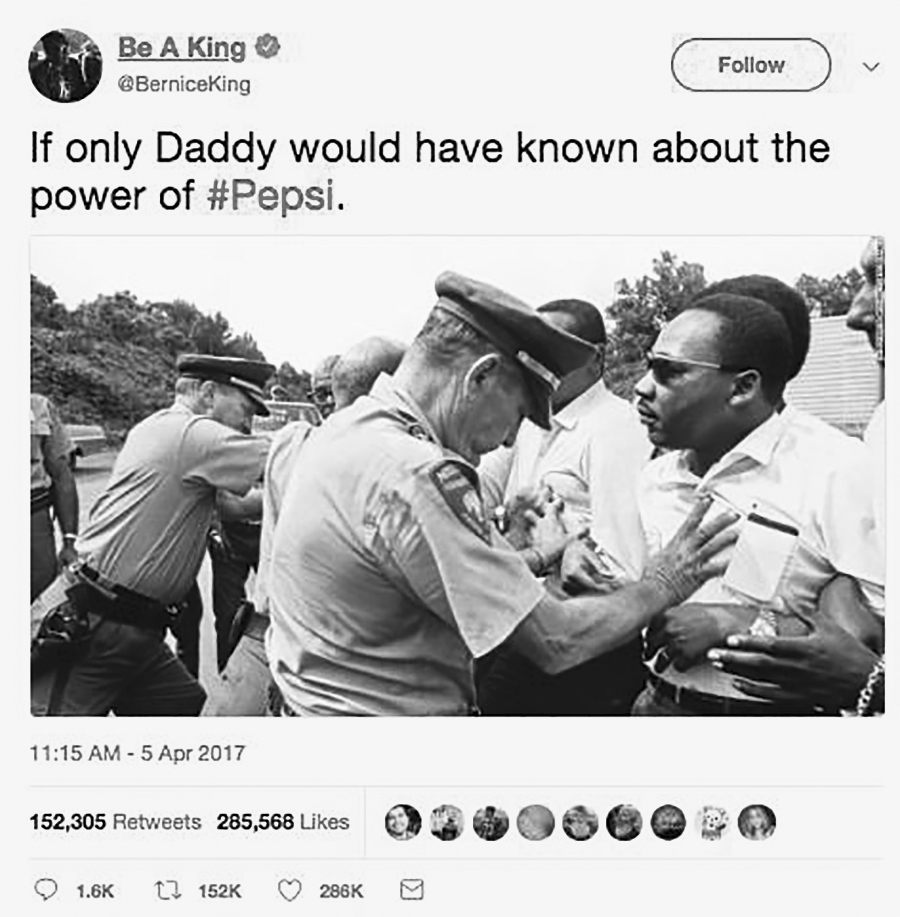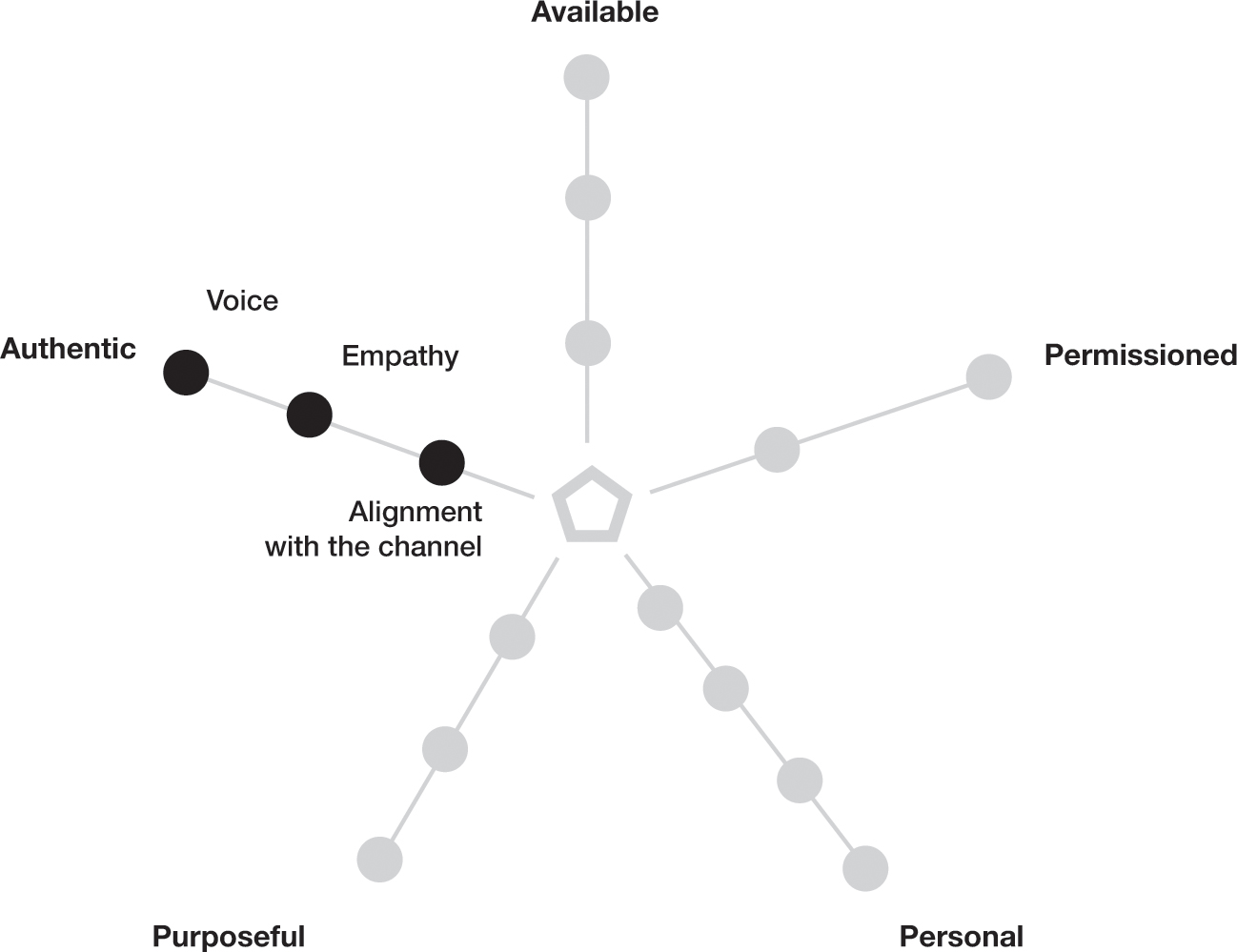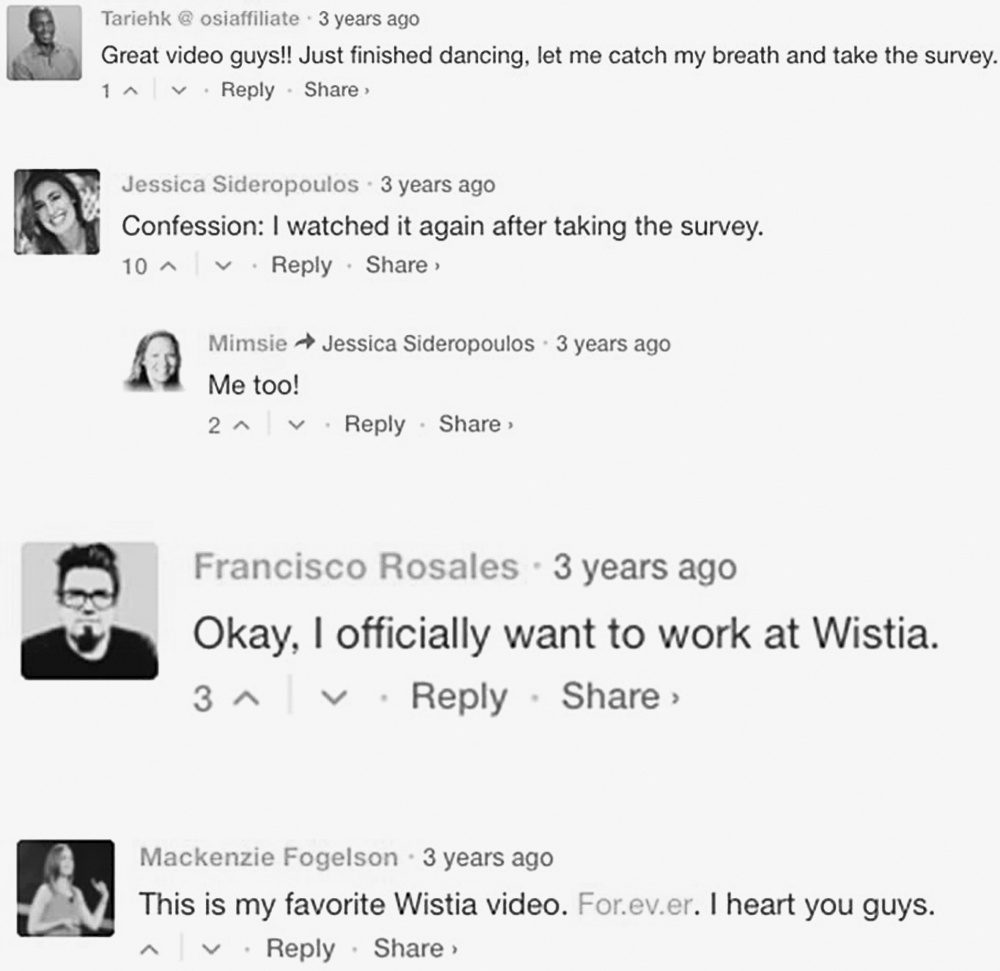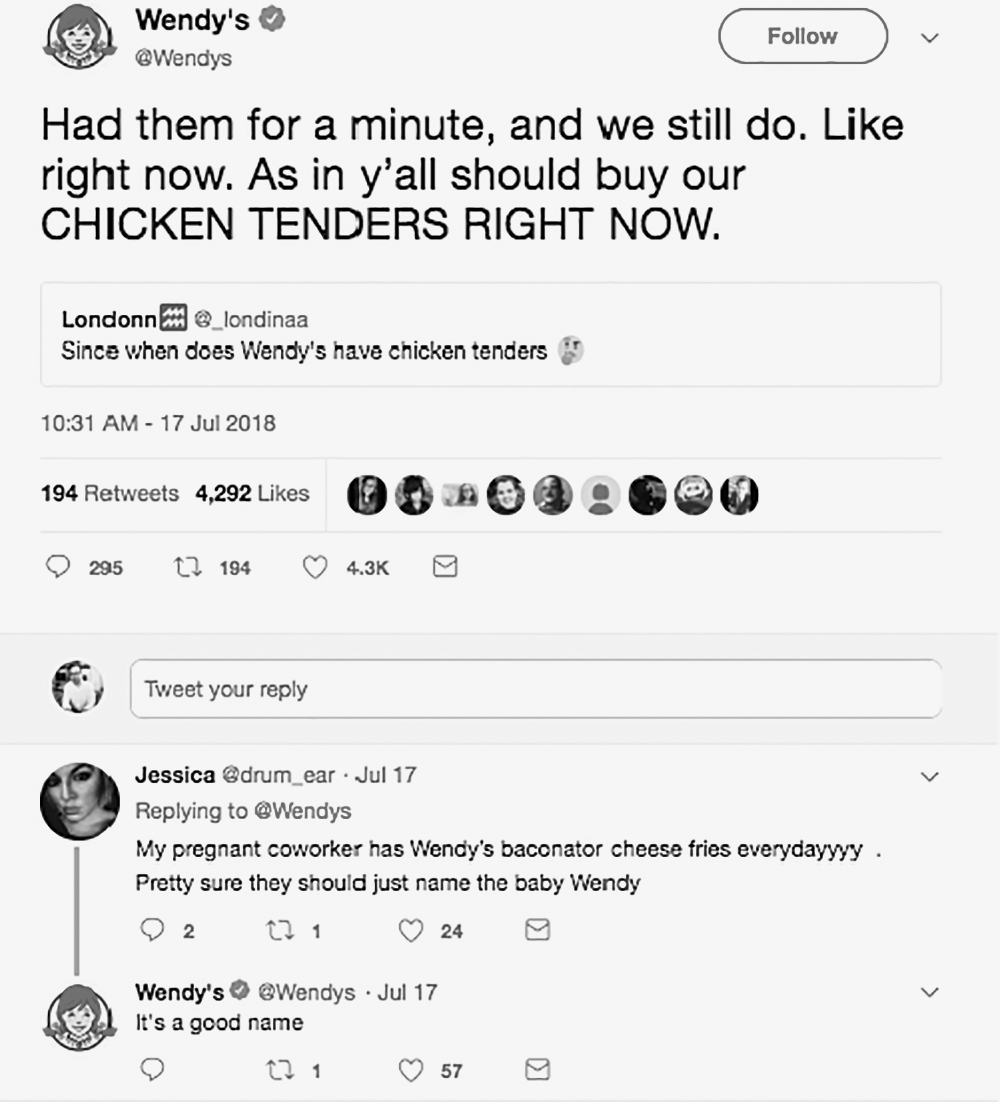7.
Authentic
Combining Voice, Empathy, and Channel Congruence Simultaneously
Authentic is easily the most subjective element of the context framework. Everyone has a different idea about what makes a communication authentic or not. But get it wrong, and you’ll pay a price. Even when your brand experience hits the most contextual levels of being available, permissioned, and personal, it will flop if it strikes an inauthentic note. Just ask Pepsi.
In a video ad featuring the model Kendall Jenner, Pepsi attempted to connect with its audience using a theme of social justice. As one of the biggest brands on the planet, Pepsi has at its disposal a cadre of ad agencies, which no doubt programmed the video as part of a coordinated campaign, from paid media to influencer marketing. Instead, the ad failed miserably and had to be pulled within days of its launch.
Pepsi didn’t simply miss the mark—it was far worse than that. Viewers were outraged at the connection that Pepsi was making between its brand and US social justice movements. Audiences saw the video as co-opting current movements and protests, a cheap attempt to piggyback on the plight of others for corporate profit. It set off a firestorm of bad press, including a tweet from Bernice King, a daughter of Dr. Martin Luther King (see figure 7-1).
There is no brand out there that could work its way back from that level of inauthenticity. At first Pepsi defended the ad as promoting diverse people coming together in a “spirit of harmony.” But within twenty-four hours of launching the ad, Pepsi pulled it and issued an apologetic message , stating that its attempt to “project a global message of unity … clearly missed the mark.”1

Source: https://twitter.com/berniceking/status/849656699464056832?lang=en.
But don’t let this example make you believe that discerning what’s authentic for your brand is always obvious. It’s not at all. That’s why it’s so easy to get it wrong, sometimes very wrong. When you reach your audience with ever-more closely defined contextual experiences—having had individual buyers’ permission to make those brand experiences available and personal, even human-to-human—the quality of your interactions becomes paramount. Everything else takes a back seat to delivering a high-quality, authentic experience. That means quality in consumers’ interactions not just with your brand, service, and products but also with every person associated with your brand: internal brand ambassadors, service specialists, influencers, even your company leaders. In short, people expect brands to be more human and more authentic at every touchpoint. Nothing else matters as much.
But what, exactly, makes something authentic? We’re all familiar with the basic meaning of authentic, especially as it refers to an object or artifact, such as a painting deemed genuine or original to a particular era or artist. Most of us also understand its meaning when we encounter other people. It’s a way to describe their bearing and style. We say that someone is authentic when he or she acts in a way that we intuit as congruent with their inner selves. That type of judgment is a more subjective—and slippery—notion, yet it remains a clear level of discernment that people tend to agree on, one way or the other. That’s the level of discernment we’re talking about with the authentic element of context.
So how do we marketers make our brand experiences authentic, or congruent, with our brand values?
The Qualities of Authenticity
Given its subjective nature, the authentic element differs in an important way from the other elements in the context framework. Rather than lying on a continuum of higher and higher levels of authenticity that marketers can seek to achieve, it contains three qualities of equal value that combine to create the quality of authenticity: voice, empathy, and alignment with the channel in which you deliver the experience. Leverage any one of those qualities and your brand experience will be more contextual. But when all are present, the experience has the best chance to ring true and engage your audience on an authentic, human level (see figure 7-2).
Voice
We all know about the importance of establishing a brand voice. But how does voice change for brand experiences that engage consumers in close context? Simply put, it gets more conversational while still tracking to the core voice of your brand. For example, if you’re a financial services brand, you might think that your voice should be strict and formal, justifying the buttoned-up tone by thinking people take money “seriously.” While people do take money seriously, the idea that these conversations have to be strict and formal isn’t true. In a conversation with Joe Hyland, while he was CMO of the financial software company Taulia, he told me the company uses humor as a part of its voice “because all people laugh.” Humans don’t want a contrived brand voice; they want a human voice that uses the basic aspects of human conversation—natural language and dialogue.
The context framework (authentic)


Compare the following two brand experiences that I recently received through LinkedIn. Which do you find more engaging?
Message A:
Hi Mathew,
My name is XXXXXX and I’m a founding partner at the teen and young adult marketing agency, XXXXX.
WHAT WE DO
- Strategy, social media, creative, and experiential marketing services
- [AGENCY] is regularly cited as a “Best Place to Work” not only in [STATE], but by Outside magazine and others, so we attract the smartest, most hard-working people in marketing
- We never stop learning, working to improve, and educating our clients about youth culture; check out some of our recent white papers
- We work for Fortune 500 companies like Amazon, Pepsi, Dick’s Sporting Goods, and others, but we also work for challengers, up-and-comers, and brands that are trying to connect with teens and young adults in an authentic way
- Since our founding in 1995, our client retention rate is 3.5x the industry average
If you think we provide the type of marketing that can be of service to you, please contact me.
Warmly,
XXXXXX
Message B:
“Hi Mathew, may I send you a copy of our marketing automation best practices guide? Based on some of your recent tweets, I thought you might be interested. Let me know (including which email address to send it to)! Many thanks, Shari”
The first message reads like a slide presentation, which makes the closing salutation, “Warmly,” seem almost comical. The brand experience is completely inauthentic (despite using the word authentic in a bullet point), but it didn’t need to be. By giving even minimal thought to the voice used (as well as making it empathic, as you will see momentarily), message A could have been transformed into an authentic human-to-human experience. For instance, the writer could have forgone the buzzwords and name-dropping in favor of using natural language, while trying to engage me in dialogue around a shared interest.
Message B, on the other hand, though brief (which often can be a plus), is much more authentic because it does those very things. The sender makes it known that she has done her homework by referring to a post I made on Twitter, she writes the note using colloquial language, and she opens up a dialogue around a shared topic. Which one do you think I responded to?
Empathy
Nobody cares about your brand. But they might begin to care, if you can prove you care about them. That’s where empathy comes in, which is different from sympathy. Sympathy is about commiseration or pity in the face of someone else’s misfortune or lot in life. Empathy goes a step further: it’s about making an effort to view and understand things from another person’s or group’s perspective. When it comes to crafting authentic brand experiences, empathy is key.
That’s especially true if you’re trying to deliver an experience to the masses, such as the Pepsi video discussed at the beginning of this chapter. By nature, such mass dissemination is automatically less contextual, lying low on the personal continuum as we explored in an earlier chapter. But that doesn’t mean such brand experiences can’t be authentic.
Pepsi went wrong because it revealed a lack of empathy, even though, according to company statements, it was attempting to show it. But people saw the ad as decidedly nonempathic for a number of reasons, starting with the fact that Pepsi used staged protest imagery featuring a fashion model (Jenner) who had no activism experience. Then, toward the video’s end, the ad clearly tried to evoke a photo that had gone viral (from a genuine protest after police killed Alton Sterling) of a young woman named Ieshia Evans facing down police in Baton Rouge, Louisiana. All that to sell soda.
Pepsi marketers hadn’t paused to imagine what it would be like for huge portions of its audience to view the ad, and it proved an expensive, brand-damaging mistake. Not only did it get the sharp perspective of Dr. King’s daughter, Bernice King, but it also received this tweet from DeRay Mckesson, an actual activist: “If I had carried a Pepsi I guess I never would’ve gotten arrested. Who knew?”
Being empathic when envisioning your brand experience won’t just protect you from mistakes like Pepsi’s. It’s also a way for brands of all sizes to break through the noise and be remembered. We want to give our audiences what they desire, not just take up their time. That’s how Wistia, a video hosting company, broke through in a big way with its marketing survey—perhaps the ultimate “hard sell.” It did it by employing some empathy.
Most of us have sat around a conference table discussing how to create better content for our audience. The Wistia team was probably doing just that when it decided it would be more authentic to simply ask audience members what they really wanted to learn from a video hosting service. That required a survey, and the marketing staff honestly hated to ask its audience to do something they themselves would hate to do. Their empathic solution? To at least make their survey request entertaining, even if they couldn’t make the survey itself very fun.
They decided to film a video in their offices, featuring a Wistia employee in the foreground and the rest of the team slightly out of focus in the background. The team member in focus begins by reading a short note laying out their conundrum: they want to make better content but need you, the viewer, to let them know what you want to learn. After she reads the note, she looks right into the camera and directly asks the audience to take the survey. Then the magic happens. The moment she finishes, she steps backward and fades into a dance line while the music rises and the entire company begins to dance the electric slide, singing in unison: “Duh, dun, dun, da, dun, dun, Take the Survey! Duh, dun, dun, da, dun, dun, Take the Survey!” The scene continues for a full minute and is completely delightful. Not only does it convey empathy for its audience, but it’s also authentic to its brand, because it’s a quirky video company that’s using a quirky video to create the experience.
Wistia is a quirky brand, so the voice of the video is what its audience expects; still, the marketing department could only hope that it would land well with its audience. The response was beyond amazing. Not only did Wistia post the highest engagement rate of any survey it has ever run, but its audience members also connected with the company like they never had before (see figure 7-3).

Source: Wistia Learning Center Blog.
In total, Wistia’s survey-request post had forty-one comments, all with similar fanfare. Just imagine: you ask people to take a survey, and rather than pulling teeth to get them to do it, those people feel so engaged that they ask to work for your company.
Similarly, Southwest Airlines has won the hearts of its customers by being completely empathic about the trials and tribulations of air travel. Not only is it one of the few airlines that still allow passengers to check their bags for free (up to two!), but it also understands how boring the flight attendant’s mandatory safety-information speech can be, especially for seasoned travelers. So what did this creative, authentic company do? Like Wistia, it decided to communicate an empathic message: we know you hate this, so we’re doing our best to make it entertaining for you. That’s why Southwest encourages flight attendants to present an animated demonstration, adding their own personality and comedic timing to entertain flyers. In an interview published in the trade publication Skift, Jeff Hamlett, captain and director of Southwest’s Air Operation Assurance, said, “As long as all of the safety and regulatory requirements are met, our flight attendants are encouraged to make onboard safety briefings engaging through the use of humor, song, or other individual twists.”2
How does Southwest know its strategy is working? Southwest customers post videos showcasing the flight attendants’ safety demonstrations—everything from a stand-up comedy routine to a rap and even a farcical exotic dance. Several of those videos went viral, with one reaching more than twenty-four million views! That’s how engaging a brand can be when it brings empathy to its experiences.
Alignment with the Media Channel
Besides getting the voice right and communicating empathy for your audience, delivering an authentic brand experience means aligning it with the media channel where people find it. Don’t make the mistake of publishing the same content on all channels. Remember Marshall McLuhan: the medium is the message. That is, an authentic brand experience on Twitter will not automatically feel authentic on LinkedIn, even though both are social media platforms. Consumers spend time on each one for very different reasons, and when you keep the brand experience authentic to the nature of the channel you can much more easily break through.
Wendy’s, the international fast-food chain, is a brand that gets it. Check out the super-conversational voice it uses to answer a question posted by a member of its Twitter audience (see figure 7-4).
As a fast-paced, real-time channel, Twitter is where people meet to converse about all kinds of things. Wendy’s has found that by joining in these conversations in a snarky and fun way, it keeps its brand relevant to that audience. Compare Wendy’s average engagement rate per post of around six thousand likes, comments, and shares with that of McDonald’s, which has a million more followers on Twitter but an average of comments, likes, and shares closer to only six hundred. That’s because most of Mickey D’s posts are product-focused and look like ads—not at all consistent with the channel and why people are on it. Wendy’s engages in natural conversation that is aligned with the channel, and that makes all the difference.

Source: https://twitter.com/wendys/status/1019243297141817344?lang=en.
That idea of authentically matching your message to the goal of the channel works for all brands, in any vertical. For example, Instagram is often thought of as a consumer channel, not conducive for business brands, but any brand that can match the authentic nature of the medium can break through on it. Notice the way WeWork matches its post to the spirit of Instagram in figure 7-5.

Source: WeWork Instagram feed.
It’s clear from this post and its audience response that WeWork, like Wendy’s, took the time to assess the unique nature of the particular media channel, which made its posts authentic to that moment. This isn’t hard to do, because each channel makes it clear what’s unique about it. Twitter limits your word count, making short, quippy conversations the ticket, while Instagram is unique in that the images are the focus of the engagement, not text. So aligning to Instagram just means shifting communication from text to images. Rather than trying to tell people via text that the WeWork offices are beautiful, well-designed, and great places to work, the company shows those things—using a natural voice, dialogue, and empathy. This is how WeWork aligned its brand experience authentically to break through.
The three qualities of the authentic element that we’ve just covered—voice, empathy, and alignment with the media channel—apply to every brand experience you create. Ignoring any of those qualities puts your brand in peril, just as paying attention to them can utterly transform how your audience perceives your brand.
Next we’ll explore the final element in the context framework, which deeply relates to authenticity. It crowns the contextual effort by helping brands meet their audience in a space of shared purpose.